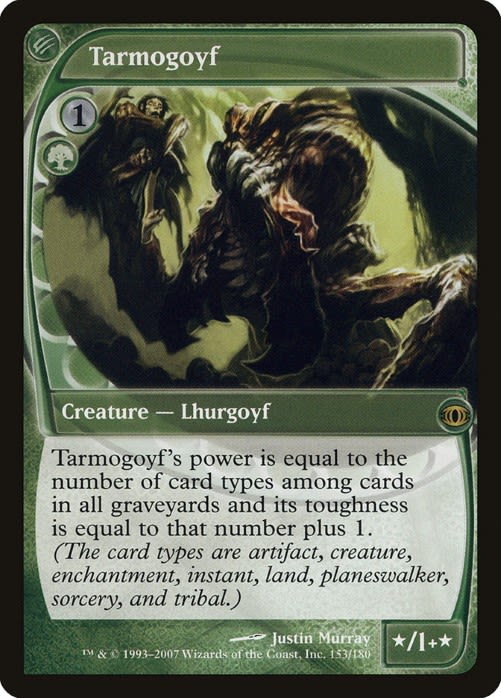Kindred first appeared in Modern Horizons 3 and is the new term for the previous "tribal" card type. The card type was originally teased in Future Sight back in 2007, including being listed on the first printing of Tarmogoyf, then was officially released in Lorwyn on cards such as Tarfire and Crib Swap.
Kindred is a card type that shares the same set of subtypes with all creature types. This allows those subtypes to be found on cards like enchantments and sorceries, for example, in addition to just creatures. Some examples might be:
- Kindred Enchantment - Eldrazi
- Kindred Sorcery - Goblin
- Kindred Instant - Faerie
- Kindred Artifact - Lhurgoyf
These used to be known as Tribal 'Card Type', and are now known as Kindred 'Card Type' as of Modern Horizons 3. All previous tribal cards have received an errata to reflect the new kindred wording.
The history of kindred cards kind of came full circle with the most recent set to use the kindred card type, Modern Horizons 3 Commander, where the card Tarmogoyf Nest can be found in one of the preconstructed decks. Unfortunately, the kindred mechanic has been retired, and it will only be seen in the occasional special set moving forward, hence its appearance in both Modern Horizons 2 and 3. But things are always changing in Magic, so who knows?
The main purpose of kindred cards was to a) provide a more flavorful experience and create a stronger connection between a race and their proprietary spells, and b) enhance a card's synergies with other cards of the same type.
For example, in Lorwyn there was an entire cycle of dual lands that each required a specific creature type to be revealed for those lands to enter the battlefield untapped. If you wanted your Gilt-Leaf Palace to enter the battlefield untapped, previously you would have to reveal a creature that was an elf, but now you could reveal an Eyeblight's Ending, which was a Kindred Instant - Elf. Ah, what a time to be alive!
Outside of being a card type that can be found on cards, the term was also a way to represent specific decks or sets that focused on a specific creature type or types. It stands to reason that these decks will now come to be known as "kindred" decks moving forward.
Some of the specific sets and blocks that focused on kindred interactions were Onslaught block, Lorwyn block, Innistrad block, and Ixalan block, to name a few. The Lorwyn Standard format was heavily focused on the kindred mechanic, and produced several notable decks, a few of which even went on to put up results in formats like Extended (RIP) and Modern.
Faeries, for example, is likely one of the most well-known kindred decks, including numerous kindred cards like Nameless Inversion and Bitterblossom. Here is Yuta Takahashi's first-place Faeries list from Grand Prix Shizouka in 2008.
Faeries | Standard, Grand Prix Shizouka 2008 | Yuta Takahashi
- Creatures (19)
- 4 Mistbind Clique
- 4 Pestermite
- 4 Scion of Oona
- 4 Spellstutter Sprite
- 3 Sower of Temptation
- Spells (16)
- 4 Ancestral Vision
- 4 Bitterblossom
- 4 Cryptic Command
- 4 Nameless Inversion
- Lands (25)
- 3 Faerie Conclave
- 4 Mutavault
- 4 River of Tears
- 4 Secluded Glen
- 4 Underground River
- 4 Snow-Covered Island
- 2 Snow-Covered Swamp
- Sideboard (15)
- 4 Bottle Gnomes
- 4 Deathmark
- 2 Familiar's Ruse
- 2 Razormane Masticore
- 3 Thoughtseize
Traditionally, a kindred deck didn't require the deck to actually have any kindred cards in it. Onslaught block was hugely "tribal," and was heavily focused on different races and classes such as birds, beasts, goblins, soldiers, clerics, etc. Here you can see Tsuyoshi Fujita's Grand Prix Bangkok winning Goblin Bidding deck from 2003.
Goblin Bidding| Standard, Grand Prix Bangkok 2003 | Tsuyoshi Fujita
- Creatures (30)
- 1 Gempalm Incinerator
- 2 Siege-Gang Commander
- 3 Goblin Sharpshooter
- 4 Skirk Prospector
- 4 Sparksmith
- 4 Goblin Piledriver
- 4 Goblin Warchief
- 4 Goblin Matron
- 4 Goblin Sledder
- Spells (7)
- 3 Patriarch's Bidding
- 4 Firebolt
- Lands (23)
- 1 Shadowblood Ridge
- 2 Swamp
- 4 Bloodstained Mire
- 4 Sulfurous Springs
- 12 Mountain
Decks based around similar creatures, like elves or goblins, have been around since Magic's inception. Originally they were called tribal decks. Now they're called kindred, just like the card type of the same name.
Frank Lepore
























